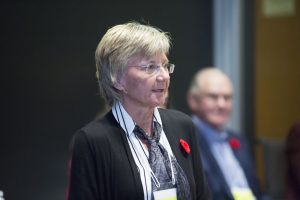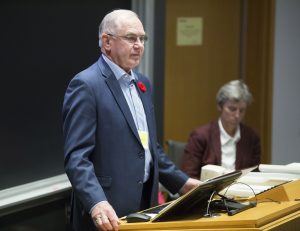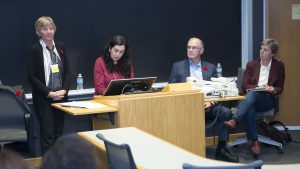Notes from our Making Connections Conference 2017
To close or not to close:
The challenge for small schools in Ontario
Speakers:Karen Pitre: Special Advisor to the Premier on Community Hubs Doug Reycraft: Chair of the Community Schools Alliance Linda Staudt: Director of Education, London District Catholic School Board Moderator: Midhat Aqeel, People for Education researcher
|
Overview:This spring, People for Education released a list of over 120 schools in Ontario that were being considered for closure. Shortly after, the government released a new plan ‘to strengthen rural and northern education.’ The plan includes more funding and a new process for closing schools. |
Session Introduction
Presentations
Click the panelists names to see notes from their presentations
- Very things that make successful classrooms is what we need in this session – relationships, collaboration, building our capacity, importance of listening/attending to diverse needs
- No one “wants” to close a school; but there is a need in some cases to do so
- Speaks to her experiences in London, Ontario-à contrast between schools
- Consolidation- you need clear communication – does everyone understand the why of it?
- Providing best opportunities for students
- We need to respond to the demographics, When we consider how to consolidate, we are following demographics of our communities
- But are we willing to listen to each other and keep that communication open? Important to maintain the relationship
- We present the best data possible, and present options
- Sometimes the answer is just a “NO”- there are no other options
- Last school closure process, there were six schools in an area where we only needed four – put the information out to the community
- Through the process, what was encouraging is that families LISTENED: even if they didn’t agree
- In some cases, they gave us another alternative
- It was in the range of options that the trustee had
- KEY POINT: maintain relationships – parents, us, communities- we never stopped listening to each other
- In the end: emotional of course, trustee had difficult discussion
- Importance of listening, and doing what is best for the students to meet their needs
- When we have too many empty seats, we HAVE to respond Now there are 4 schools and we will invest in those schools- now will support families and students in transition
- Now, different ministries across provinces are talking to each other
- Collaboration is key at ministry/provincial level as well
- Background: taught for 30 years in 1 room school with 8 grades; elementary; secondary; secure custody for young facilitators; experience in government as well
- advocating for a more collaborative relationship between school boards & municipalities in terms of locations for new schools and school closures
- Grant for Student Needs allocated $24 billion – distributed amongst Ontario school boards based on numbers of students
- GSN formula has many components, sensitive to needs/characteristics of each board
- Some boards will get $25 000, while others get $10, 000 or less, it depends
- Ontario northern and rural boards are smaller, spread apart
- Challenge for school boards to provide the same opportunities to students in rural areas as those concentrated in urban areas
- Rural schools smaller; underutilized, unused space
- Surplus space and size make a difference
- Controversial/unpopular when school closes
- Consequences for rural vs urban schools are NOT the same:
- Significance of a school closing in a rural community is dramatic
- in rural areas, students may spend many hours every week travelling to school in another community
- School is no longer short ride or walk; they can no longer study or learn with classmates who are their neighbours
- limits their abilities to participate in after school activities/ hold job
- Changes students’ lives – the funding formula has negative effect for these students
- Families will look elsewhere for schools when they know school is closing to settle roots
- Rural communities with schools are different in a number of ways from communities that don’t have them:
- Communities with a school have higher housing values, higher housing stock, lower poverty rates, more income equality
- On virtually every indicator- rural communities with schools rank higher than communities without
- In communities with a school, it is the centre for other activities- sports, theatre, etc. If it closes, communities lose this resource
- Good news:
- Ministry has released a plan to strengthen rural and northern education, effective this September.
- Each board allocation based on students in board and needs
- Review of guidelines in place
- Accommodation process must be improved; and input on community impact has to be considered
- Rural education strategy – in 90 days, put together report with 27 recommendations
- asked people to give advice on how to fix it; not what’s wrong
- tell us what to do; give us suggestions to fix
- 27 recommendations that government accepted and are implementing
- changes to regulation to give more time
- expanded funding for community
- most difficult recommendation: integration of provincial planning and local planning
- trying to get ministries to look outside their world and say as a province we have an interest in this
- we are selling property, not solving the problem—we need that property for something else—but school boards are encouraged to sell ‘excess space’ as fast as they can
- demographics have changed now: aging communities
- at provincial level – we need integrated provincial planning table
- we are using surplus property as a vehicle to get people to the table
- it is extremely sensitive and relationships are important
- who should be planning for what? It is a difficult conversation
- everyone has their own “data” and will use it to their own advantages
- how do we meet common interests? Relationships, collaborations and trust
- we need to start the PLANNING conversation before we talk about pupil accommodation
- need ongoing conversation in the community, so it is not a huge surprise when they realize there is excess capacity
- community hubs will not solve all the problems
- what is helpful – think about what are the services/needs in community and where is the best place to deliver them? May or may not be open or closed schools
- we continue to build schools the way we have always been doing: we need a new approach
- we are trying to get governments to think differently about how they are doing this
- the world is changing, and how we have these conversations are changing- we can’t continue to do the same things we have always been doing. It is difficult, but we need to think bigger
 Linda Staudt |
 Doug Reycraft |
 School closing presenters |
Audience Q&A:
Q1: issues surrounding money; why don’t we fix buildings instead of tearing them down?
- Karen: difference between money & programs
- Linda: programming needs of a small school are different
- Doug: what we have followed generally with respect to closing schools is policies that ignore whether it is urban vs. rural. I make the case that school closings in a single-school community has BIG consequences that are different from urban areas
Q2: What is education doing to foster online learning?
- Doug: trying to take advantage of new technologies
- Linda: you will still need opportunities for students
- Karen: it is harder than you think; not all will agree
Q3: Relationship b/w school boards & municipality
- Karen: we need school boards and municipality that come forward together and say I would like to do this; interest together to say how do we do this
Q4: Community Partnerships? Relationship between space and community? Who owns the space?
- Karen: people can use communityhubsontario.ca site to connect with others who are working to create community hubs
